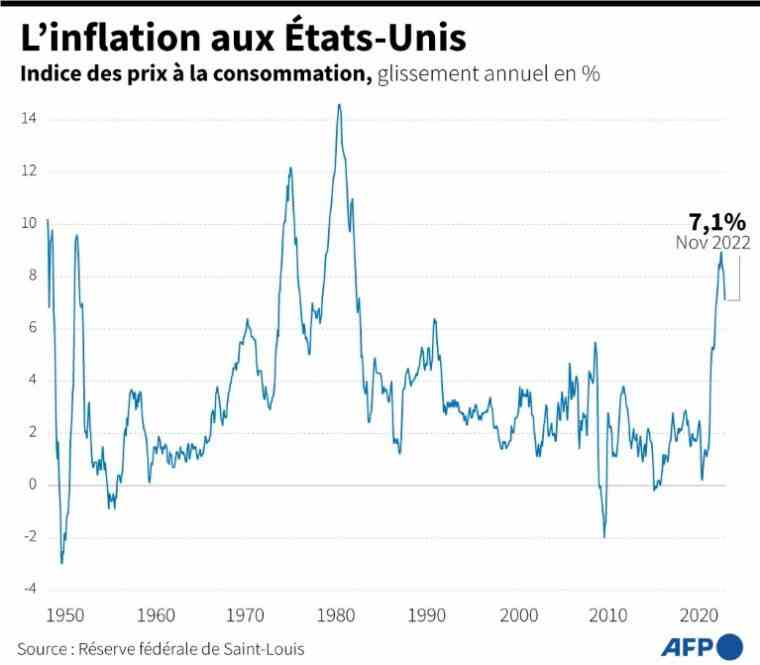Jerome Powell during his press conference in Washington on December 14, 2022 (AFP/Nicholas Kamm)
The second phase of the fight against inflation has been launched in the United States, where the central bank, after raising its rates very sharply since the spring, is now slowing the pace and has drastically reduced its growth forecast for 2023.
The US central bank (Fed) on Wednesday raised its main interest rate by half a percentage point. This is now in a range of 4.25 to 4.50%, the Fed announced in a press release published after its meeting, stating that the decision was taken unanimously.
This is the highest level since 2007. And the Fed warned that it was not yet time to stop: further increases “will be appropriate”, specifies the institution.
Its officials even plan to make them climb beyond 5.00%, whereas they anticipated 4.6% in the previous forecasts, published in September.
Because, if the rise in prices has shown a “welcome slowdown”, underlined the President of the Fed Jerome Powell, during a press conference at the end of this meeting, he estimates that “it will take significantly more evidence to be confident that inflation is indeed on an easing trend”.
This lower than previous rise in rates marks the start of a new phase in the fight against inflation, the Fed’s priority.
Faced with a rise in prices, the highest in more than 40 years, the Fed has pulled out heavy artillery since the start of the year, raising its rates by three-quarters of a point on four occasions, a level of increase which she had not used since 1994. But the effects of her decisions take months to be felt.
– Slow decline –
The Fed, however, is a little less optimistic than in September on the trajectory of inflation, and now sees it slowing down to just 3.1% in 2023, whereas it was counting on 2.8% previously, according to the PCE index that it favors and wants to bring back around 2%.
For 2022, it expects 5.6%, against 5.4% three months ago.

Evolution of the consumer price index in the United States since 1948 (AFP / )
It has also drastically reduced its growth forecast for 2023, now counting on 0.5% against 1.2% previously. However, it raised it a little for this year, also to 0.5%, against 0.2% previously.
The institution does not mention a recession for next year, despite the risks caused by its fight against inflation, which could slow down economic activity too much.
“I don’t think anyone knows whether or not there will be a recession” in the United States, said Jerome Powell.
The Fed’s key rate was, until March, between 0 and 0.25%, a floor level intended to support the economy during the Covid crisis by stimulating consumption.
This had also been driven by the particularly high level of savings of Americans, at the very time when many goods were becoming more difficult to obtain because of the world’s supply difficulties and the shortage of labour. As a result, prices had skyrocketed.
– “Structural labor shortage” –
If the decline has started, it remains slow.
Inflation slowed sharply in November, to 7.1% from 7.7% in October, according to the CPI index.
As for the unemployment rate, currently 3.7%, the Fed sees it rising to 4.6% in 2023 and 2024, a little higher than the 4.4% it previously forecast, which “remains very solid “, further commented the chairman of the Fed.

The Fed building on August 18, 2022 in Washington ( AFP / MANDEL NGAN )
Employers should still struggle to hire in the near future, because the country is facing a “structural labor shortage”, with “4 million people missing”, due, he explained. , early retirement, the million and a half deaths from Covid, and insufficient immigration.
This forces companies to raise salaries to attract applicants and retain staff.
“I don’t think we’re in a price-wage spiral,” Treasury Secretary Janet Yellen told reporters last week.
The European Central Bank (ECB), which will meet on Thursday, could also move on to the second phase of the fight against inflation, and slow down the pace, after having operated since July an unprecedented monetary tightening in its history.

